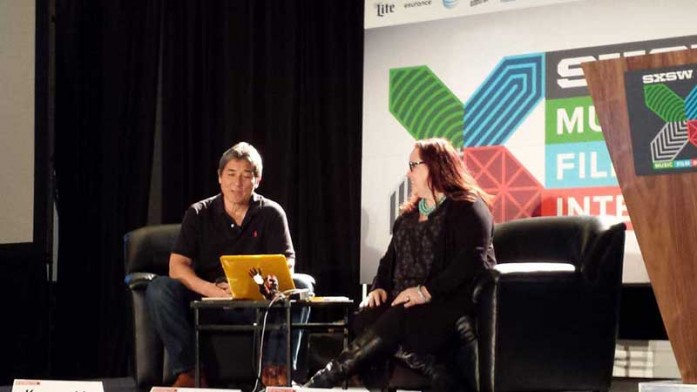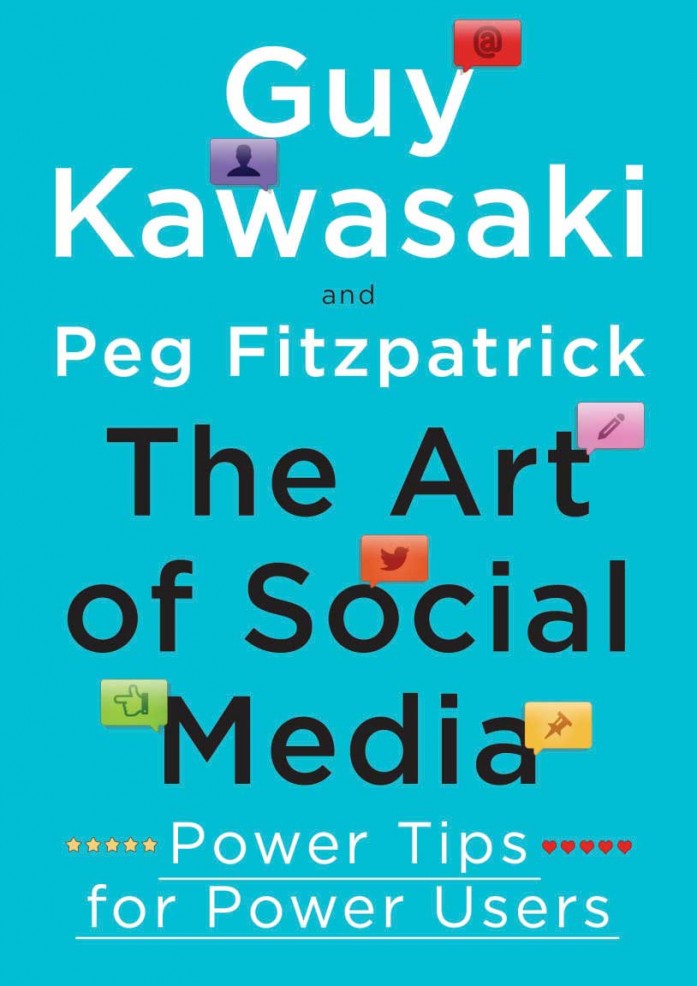After a lot of fuss and apparently different marketing methods, The Art of Social Media – Power Tips for Power Users, last book authored by Guy Kawasaki, was launched in December 2014, but until now I couldn’t find the time to touch it. It was a very easy read for me, mostly because I am familiar with what they talked in there. “They” meaning Guy Kawasaki and Peg Fitzpatrick, his co-author, or better said, team mate, because the book was written only in Guy Kawasaki’s voice.
You can find and follow them on Twitter here: @GuyKawasaki and @PegFitzpatrick
I know that in the meantime, a sequel of Guy Kawasaki’s 2004 book, The Art of the Start, with the new title The Art of the Start 2.0 was launched, but still, I consider The Art of Social Media his last.

Guy Kawasaki with Peg Fitzpatrick
[source]
Social Media is explained to a new level which if it was intuitive at first, now reinvents itself. You already know, Social Media is a powerful industry with many billion dollar companies disputing their supremacy. Normal people enjoy the relationships they develop on Social Media, but the industry has to grow by what it is paid in order to feed the normal people, and push them to buy whatever crappy product has been endorsed to them by the so called Social Media gurus.
Beside the use of the term “idiot” three times on two consecutive pages, Guy Kawasaki lost his initial modesty and charm, with this book. But even so, he is right most of the time. You have to let loose your originality because it doesn’t sell. “Original” is overrated unless one people designated “expert” will tell you so, and if you don’t try to advance by using the same bland sort of post titles that sell, you don’t advance at all, and you also risk to be ignored by the ones you have until yesterday considered your peers. By expert he understands one who is considered so by others, not one who auto-designates himself as an expert. So, I say that an expert is pushed down your throat by other experts, self designated or not, because they form a majority who can switch your mind with their massive following. You know, another idea transparent in this book is that in order to achieve success, you have to go with the stream, not against it. You have to give up your presumed Messianism, otherwise you won’t have that Social Media Manager job you desire.
Guy Kawasaki aggressively shows his contempt for SEO specialists. He considers them cheats who will never beat the multi-billion dollar system robots which present in your searches only what is considered “relevant” by itself, the same system robots who apparently don’t know if your post is for designers or about travel, if you don’t help them with hashtags. Guy Kawasaki goes with the winners, and he will never antagonize them, which is the healthiest attitude someone can have.
Everything said in the book is obvious and everyone who ever understood what Social Media really is, doesn’t really need it. One needs at least two years of constant activity on minimum one platform which is not reddit. Of course, more platforms offer more exposure for you or for the company you represent. The new young bloods in stripes with master’s degree in PR need it but the book’s information is over their minimum level of comprehension. They won’t have the patience to fully read it and they will continue to throw their employers’ funds on the window by buying followers or likes, and organize parties where they invite only their elitist PR friends along some fresh meat and a potential “new business” they hope to con in becoming “clients”.

The Art of Social Media – Book Cover
[source]
I like a lot the “to do” checklist from the chapter before last’s valuable info which comes just to complete the extended advice presented in APE, Guy Kawasaki’s previous published work. I also appreciated the frankness, which I consider a good thing despite being advised on the contrary. “Don’t be advised by an agent with less followers then yours”, is my favorite phrase.
I continue to dislike most of the stereotypical titles presented in the “74 clever blog post title templates that work” infographic. I know they “work”, but I still wonder if they only trigger the superficial, the people expecting from the internet to tell them what to do, what to eat and what to wear, like they expect from the television to be told who to vote with and what to think from time to time.
The book advocates boldness and the total annihilation of trolls, it is stuffed with product promotion, but anyway, the endorsements could be expenses better used than buying followers and likes. I have been impressed by the most logical advice of all, which generally sounds as follows: If you are not a professional yourself, employ one for each operation. You need rapid typing during a Twitter chat? Employ the services of a fast typewriter of whom you dictate your precious pearls with only 140 characters. You need an accurate photo of an event? Employ the services of a photographer who knows what is the best for you, etc… The only thing you can’t employ, is someone to think for you. You’ll be out of your job, so better read the book from the first page. “It’s a code” says Guy Kawasaki, which will function for you no matter how Social Media will change.
If you liked what you read (and for that I humbly thank you for your patience), subscribe to this blog by Email! Follow this blog on Twitter, and on Facebook! For a joyous day, check out my pins on Pinterest or my grams on Instagram 😄. I hope you like this blog so much that you think it’s time to take a step further by becoming yourself a blogger; in order to do that have the kindness to read the Own Your Website offer I have prepared for you! You won’t regret. Thanks for passing by 😄 Speak your mind, don’t be shy!

How about this?
https://youtu.be/sDGuc7G6PRs
(Maybe it has to do with the article)
It’s just perfect, thank you very much:)